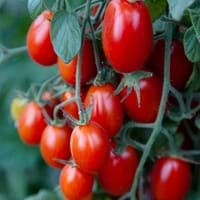Life Span
Biennial and Perennial
Annual and Perennial
Origin
Europe, Western Asia
Mexico, Central America, South America
Types
Not Available
Cherry tomato, Beefsteak tomato, Medium tomato
Habitat
waste ground, wastelands
Loamy soils, Shaded sites
USDA Hardiness Zone
4-9
11-15
Sunset Zone
A1, A2, A3, H1, H2, 1a, 1b, 2a, 2b, 3a, 3b, 4, 5, 6, 7, 8, 9, 10, 11, 12, 13, 14, 15, 16, 17, 18, 19, 20, 21, 22, 23, 24
A1, A2, A3, H1, H2, 1a, 1b, 2a, 2b, 3a, 3b, 4, 5, 6, 7, 8, 9, 10, 11, 12, 13, 14, 15, 16, 17, 18, 19, 20, 21, 22, 23, 24
Habit
Rosette/Stemless
Vining/Climbing
Flower Color
Yellow
Yellow
Flower Color Modifier
Bicolor
Bicolor
Fruit Color
Brown, Black
Red
Leaf Color in Spring
Green
Green, Dark Green
Leaf Color in Summer
Green
Green, Dark Green
Leaf Color in Fall
Green
Green, Dark Green
Leaf Color in Winter
Not Available
Green, Dark Green
Leaf Shape
Pinnate
Elliptic, toothed
Plant Season
Summer
Spring, Summer, Fall
Sunlight
Full Sun
Full Sun
Type of Soil
Loam
Loam, Sand
The pH of Soil
Neutral
Neutral
Soil Drainage
Well drained
Well drained
Bloom Time
Summer
Indeterminate
Tolerances
Drought
Drought
Where to Plant?
Ground, Pot
Container, Ground, Pot
How to Plant?
Seedlings
Seedlings, Transplanting
Plant Maintenance
Medium
Medium
Watering Requirements
Average Water Needs, Do Not over Water, Keep the ground moist but not water-logged
Allow to dry out slightly between watering, Do not water the foliage, Needs 2-3 times watering per week
In Summer
Lots of watering
Lots of watering
In Spring
Moderate
Moderate
In Winter
Average Water
Average Water
Soil Type
Loam
Loam, Sand
Soil Drainage Capacity
Well drained
Well drained
Sun Exposure
Full Sun
Full Sun
Pruning
Remove damaged leaves, Remove dead branches, Remove dead leaves
Remove damaged leaves, Remove dead branches, Remove dead leaves, Remove short branches, Remove short twigs
Fertilizers
All-Purpose Liquid Fertilizer
Apply 5-10-5 amounts
Pests and Diseases
Aphids, Armyworm, Cutworms, Downy mildew, Pitch canker, Red blotch
Red blotch
Plant Tolerance
Drought
Drought
Flower Petal Number
Not Available
Single
Fragrant Bark/Stem
Yes
Yes
Foliage Texture
Fine
Medium
Foliage Sheen
Matte
Matte
Attracts
Butterflies
Aphids, Bees, Butterflies, Mosquitos
Allergy
Stomach burn
Diarrhea, gastro-intestinal problems, Headache, Itchiness, Vomiting
Aesthetic Uses
Not Available
As decorated salad
Beauty Benefits
Blood purifying, Good for skin
Acne, Glowing Skin, Maintains teeth healthy
Environmental Uses
Air purification
Air purification
Medicinal Uses
Aphrodisiac
Antioxidants, Metabolism
Part of Plant Used
Root
Fruits, Leaves
Other Uses
Food for animals, Used as a nutritious food item
Cosmetics, Culinary use, For making oil, Repellent
Used As Indoor Plant
Yes
Sometimes
Used As Outdoor Plant
Yes
Yes
Garden Design
Edible, Herb, Vegetable
Container, Edible, Herb, Vegetable
Botanical Name
PASTINACA sativa
LYCOPERSICON esculentum var cerasiforme 'Grape'
Common Name
Parsnip
Grape tomato
In Hindi
चुकंदर
अंगूर टमाटर
In German
Pastinake
Traube Tomate
In French
Panais
tomate uva
In Spanish
Chirivía
tomate uva
In Greek
Είδος δαυκίου
ντομάτα σταφυλιών
In Portuguese
cherivia
tomate uva
In Polish
Pasternak
pomidorowa z winogro
In Latin
parsnip
uva tomatoes
Phylum
Magnoliophyta
Magnoliophyta
Class
Magnoliopsida
Magnoliopsida
Family
Apiaceae
Solanaceae
Clade
Angiosperms, Asterids, Eudicots
Angiosperms, Asterids, Eudicots
Tribe
Not Available
Solaneae
Subfamily
Not Available
Solanoideae
Number of Species
Not Available
Not Available
Season and Care of Parsnip and Grape Tomato
Season and care of Parsnip and Grape Tomato is important to know. While considering everything about Parsnip and Grape Tomato Care, growing season is an essential factor. Parsnip season is Summer and Grape Tomato season is Summer. The type of soil for Parsnip is Loam and for Grape Tomato is Loam, Sand while the PH of soil for Parsnip is Neutral and for Grape Tomato is Neutral.
Parsnip and Grape Tomato Physical Information
Parsnip and Grape Tomato physical information is very important for comparison. Parsnip height is 15.20 cm and width 7.60 cm whereas Grape Tomato height is 30.00 cm and width 30.00 cm. The color specification of Parsnip and Grape Tomato are as follows:
Parsnip flower color: Yellow
Parsnip leaf color: Green
Grape Tomato flower color: Yellow
- Grape Tomato leaf color: Green and Dark Green
Care of Parsnip and Grape Tomato
Care of Parsnip and Grape Tomato include pruning, fertilizers, watering etc. Parsnip pruning is done Remove damaged leaves, Remove dead branches and Remove dead leaves and Grape Tomato pruning is done Remove damaged leaves, Remove dead branches, Remove dead leaves, Remove short branches and Remove short twigs. In summer Parsnip needs Lots of watering and in winter, it needs Average Water. Whereas, in summer Grape Tomato needs Lots of watering and in winter, it needs Average Water.





